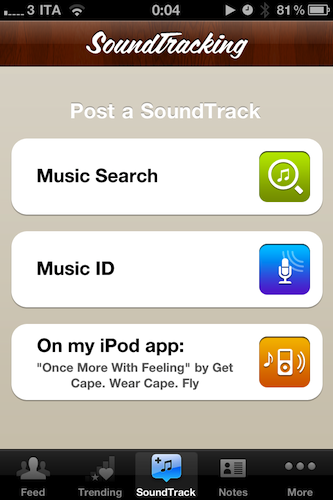Last week I decided to refine my cloud storage and music streaming setup: I bought a Dropbox Pro 50 account and extended my Spotify subscription until September. In case you don’t know, I store my iTunes library on Dropbox so I can sync my iOS devices effortlessly across all the computers I’ve installed Dropbox on. But why using iTunes and Spotify together for storing and streaming music? For as much as I love Spotify – in fact, it changed my music listening habits since I started using it – not every artist I like is available on it. That’s why I care about keeping a well-organized iTunes library with the albums and songs not available on Spotify. This library is pretty huge and stored on Dropbox together with apps, books, movies and anything else that usually goes into iTunes.
With a 16 GB iPhone, the combination of iTunes + Spotify (which also happens to have an offline cache option) gives me the possibility of having any kind of music ready for listening whenever I like. SoundTracking, a new app for iPhone I installed a few days ago, aims at giving you the tools to share the “soundtrack of your life” and discover new songs shared by your friends, directly from your iPhone.
At first, SoundTracking might sound like an “Instagram for music” – that would actually make sense after all the Instagram alternatives and third-party apps we’ve seen recently, not to mention the Instagram for video SocialCam. SoundTracking starts from the same simple concept of Instagram: you open the app, tap on a button in the toolbar and share media with your social graph in seconds. In SoundTracking, that means you’re sharing the song and artist you’re currently listening to with friends using the app you discovered by logging into Twitter, Facebook and Foursquare. But the similarities with Instagram stop at the basic concept, as SoundTracking goes really in-depth to allow you to not only share, but also discover new music and people with your same music tastes worth following.
Upon firing up the app you’ll be asked to log into the aforementioned social services so you can “import” friends that are already using SoundTracking. These friends, together with other stats such as likes and “loves”, will be available in the More tab under “My Profile”, which provides a summary of your music activity, followers and following count. In the same “More” tab you can also tweak the settings to change sharing options, email and push notifications. Thank god this app comes with a “quiet time” option that allows you to stop receiving push notifications at a certain time during the day.
So how do you share music? Simple. If any music is playing in your iPod app, you can head over the SoundTrack button, choose iPod and watch the app fill the required fields for you. If music info are correctly set up in your iTunes library, SoundTracking should automatically grab artist, song and album artwork. You can add any other photo from the iOS Camera if you don’t feel like sharing the album artwork, add a location thanks to Foursquare integration and even add a description to the song you’re listening to. Hit preview, and the app will display the status update you’re about to share with your friends. A bar at the top enables you to choose whether or not this SoundTracking message should also be forwarded over to Twitter, Facebook, or Foursquare. When viewed on the iPhone or on the web, SoundTracking status updates display a Play button that lets you listen to the iTunes preview for a song. A link back to the iTunes Store allows you to buy or discover music within seconds.
Sharing music from the iPod.app isn’t the only way to interact with SoundTracking. You can manually enter all the details of the song you’re listening to in the “Music Search” tab or discover a song through the iPhone’s mic with Music ID, based on the Gracenote online database. Pretty much like in Shazam or SoundHound, the app will listen for sounds, and try to match them with a song stored in the database. One thing I miss from the current version of SoundTracking is Spotify integration: most of the times I’m listening to songs on the Spotify iPhone app, and SoundTracking can’t see it at all.
The social feed in SoundTracking displays status updates from all the people you decided to follow, like Twitter. Tap on a message, you’ll see the song’s iTunes link and album artwork / photo, location and buttons to like, “love” and comment. Comments are displayed in a transparent overlay to the album artwork or photo.
SoundTracking is a young platform, but it’s impressive in its first release and has got huge room for growth. Integration with more iOS apps and a native iPad client would be great, as well as having the possibility to share music from the desktop, or plug into last.fm altogether. As it stands now though, SoundTracking has become one of my favorite new ways to share something personal like my music tastes and moments with my followers, and I think that’s a great accomplishment. SoundTracking is available for free in the App Store.
Check out Robert Scoble’s interview with CEO Steve Jang below. By the way, I’m “viticci” on SoundTracking.





